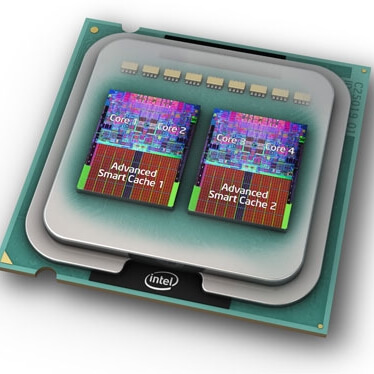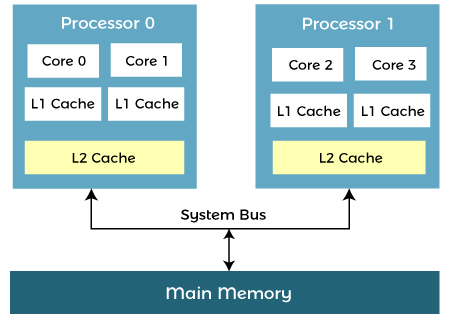What is a Multicore Processor?A multi-core processor is an integrated circuit with two or more processors connected to it for faster simultaneous processing of several tasks, reduced power consumption, and for greater performance. Generally, it is made up of two or more processors that read and execute program instructions. In other words, on a single chip, a multi-core processor comprises numerous processing units, or "Cores," each of which has the potential to do distinct tasks. For instance, if you are performing many tasks at once, such as watching a movie and using WhatsApp, one core will handle activities like watching a movie while the other handles other responsibilities like WhatsApp. 
A dual-core configuration is comparable to having several different processors installed on the same computer, but the connection between them is faster because the two CPUs are plugged into the same socket. Several instructions in parallel may be executed by individual cores, boosting the speed of software built to make use of the architecture's unique features. As compared to a single-core processor, a dual-core processor usually is twice as powerful in ideal circumstances. In actuality, performance gains of around 50% are expected: a dual-core CPU is roughly 1.5 times as powerful as a single-core processor. As single-core processors hit their physical limits of complexity and speed, multi-core computing is becoming more popular. In modern times, the majority of systems are multi-core. Many-core or massively multi-core systems refer to systems with a huge number of CPU cores, such as tens or hundreds. In the early 2000s, Intel and AMD released the first multicore processors. In modern times, CPUs come with two ("dual-core"), four ("quad-core"), six ("hexa-core"), and eight ("octa-core") cores ("octo-core"). FPGA-based processors contain up to 100 physical cores and 1000 effective independent cores (Field Programmable Gate Arrays). Architecture of Multicore ProcessorA multi-core processor's design enables the communication between all available cores, and they divide and assign all processing duties appropriately. The processed data from each core is transmitted back to the computer's main board (Motherboard) via a single common gateway once all of the processing operations have been finished. This method beats a single-core CPU in terms of total performance. 
Advantages of Multi-Core ProcessorMulticore processors have a number of advantages (pros), including: PerformanceA multi-core CPU, by nature, can do more work as compared to a single-core processor. The spacing between the cores of an integrated circuit allows for faster clock rates. As a result, the signals do not need to travel a large distance to reach their target and are also persistent. When compared to using a separate processor, the speeds are far quicker. ReliabilityIn multi-core CPUs, the software is always assigned to different cores. When one piece of software fails, the others remain unaffected. Whenever a defect arises, it affects only one core. As a result, multi-core CPUs are better able to resist faults. Software InteractionsEven if the software is running on multiple cores, it will communicate with one another. Spatial and temporal isolation is a process that a multi-core processor goes through. Core threads are never delayed as a result of these processes. MultitaskingAn operating system can use a multi-core CPU to run two or more processes at the same time, even if many programmes may be executed at the same time. A photoshop application, for example, can be used to perform two jobs at once. Power ConsumptionMultitasking with a multi-core CPU, on the other hand, requires less power. Only the part of the CPU that generates heat will be used. The power consumption is eventually minimized, resulting in less battery utilization. Some operating systems, on the other hand, need more resources as compared to others. Obsolescence AvoidanceArchitects can avoid technology obsolescence and increase maintainability by using multicore CPUs. Chipmakers are using the most recent technological advancements in their multicore CPUs. Single-core chips are becoming increasingly difficult to come by as the number of cores increases. IsolationMulticore processors may increase (but do not guarantee) geographical and temporal isolation when compared to single-core systems. Software on one core is less likely to impact software on the other if both cores are executing on the same single-core. This decoupling happens due to geographical and temporal isolation (threads on one core are not delayed by threads on another core). With the help of limiting the impact of errors to a single core, multicore processing can increase robustness. When executing mixed-criticality programmes separately, this enhanced isolation is very important (safety-critical, mission-critical, and security-critical). Some other key points of benefits of Multicore Processor:
Disadvantages of Multi-Core ProcessorsWe will go through some of the limitations (drawbacks) of a multi-core processor, including: Application SpeedDespite the fact that a multi-core CPU is designed for multitasking, its performance is insufficient. It has a tendency to bounce from one core to the next each time when an application is processing. As a result, the cache fills up, increasing its speed. JitterMore interference develops as the number of cores in a multi-core CPU increase, resulting in excessive jitters. As a result, your operating system's program performance may suffer, and frequent failures may occur. Only by using appropriate synchronization and a microkernel will the user be able to deal with jitter. AnalysisWhen you are doing two or more things at once, you will need to employ additional memory models. In a multi-core machine, this makes analysis tough. Time limitations, in particular, are difficult to determine and may be inaccurate. Furthermore, the interference analysis becomes more complex as the number of cores increases. Consequently, the O/S will be unable to deliver produce the promised results. Resource SharingA multi-core processor shares a variety of resources, both internal and external. Networks, system buses, and main memory are among these resources. Consequently, any program running on the same core will have a higher chance of being interrupted. Both geographical and temporal isolation can occur in this form of interference. Software InterferenceDue to resource sharing, software interference can cause problems with spatial and temporal isolation. If there are additional cores, this chance increases even more. The presence of more cores implies a greater number of interference routes. It is nearly impossible to examine all possible interference pathways. Some other key points of limitations of Multicore Processor:
Why is Multi core Processor used?The configuration is similar to a dual-core processor. Multi-core processors are classified according to the number of cores and the types of cores. A multi-core CPU's objective is to obtain great performance. It was designed to get past the physical limitations of a single-core CPU. Supportive Operating Systems of Multicore Processor include:
A brief history of multicore processorsBecause the companies who created the initial chip-based processors could only put one processor on a single chip, they could only fit one processor on a single chip. Chipmakers were able to construct chips with more circuits as chip-making technology progressed, and finally, chipmakers were able to make chips with more than one processor, resulting in the multi-core chip. In 1998, the first multi-core processor was invented by Kunle Olukotun, a professor of electrical engineering at Stanford, and his students. Multicore chips were first commercially accessible in 2005 from Advanced Micro Devices (AMD) and Intel. Almost every chip maker has since started to create multicore processors. Where are multicore processors used?In modern times, multicore processors are found in the majority of devices such as tablets, desktops, laptops, smartphones and gaming systems. The two core options provided demonstrate how a processor's model does not tell the entire story regarding performance. As compared to a dual-core i5, the performance of a quad-core i5 is substantially superior, and the price of the computer will reflect this. All of the current laptop models for the i5 model are dual-core, whereas all of the desktop models are quad-core as of this writing. Because laptop versions are dual-core rather than quad-core, an i5 in a laptop will have poorer performance than an i5 on a desktop. The dual-core type is better suited to portable laptops that require longer battery life and consumes less power, but a desktop uses a CPU that uses more power, such as the quad-core model, as it does not require battery life. Some applications of the multicore processor are as follows:
|
 For Videos Join Our Youtube Channel: Join Now
For Videos Join Our Youtube Channel: Join Now
Feedback
- Send your Feedback to [email protected]
Help Others, Please Share









